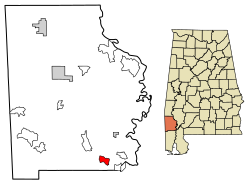Fairford, Alabama | |
|---|---|
 Location of Fairford in Washington County, Alabama. | |
| Coordinates: 31°10′41″N88°04′22″W / 31.17806°N 88.07278°W [1] | |
| Country | United States |
| State | Alabama |
| County | Washington |
| Area | |
• Total | 3.07 sq mi (7.95 km2) |
| • Land | 3.07 sq mi (7.95 km2) |
| • Water | 0 sq mi (0.00 km2) |
| Elevation | 151 ft (46 m) |
| Population (2020) | |
• Total | 161 |
| • Density | 52.4/sq mi (20.24/km2) |
| Time zone | UTC-6 (Central (CST)) |
| • Summer (DST) | UTC-5 (CDT) |
| Area code | 251 |
| GNIS feature ID | 2628589 [1] |
Fairford is a census-designated place and unincorporated community in Washington County, Alabama, United States. Its population was 186 as of the 2010 census. [3]
